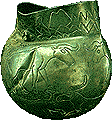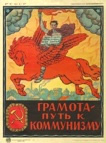
Making generalizations about the visual culture of any group of people is a crude endeavor, especially with a culture as diverse as Russia's. With this thought in mind, know that this survey, as any must be, is tremendously limited in its breadth and depth.
![]()
Examples:

Russia, North Caucasus, Maikop Burial Mound,
Vessel Decorated with Animals and a 'Landscape',
middle of the 3rd millennium
BCE,
silver, height
9.6 cm, Hermitage Museum, St. Petersburg, Russia.

Russia, Plaque
with the Virgin (and Plaque with St. Mark the Evangelist),
12th century, gold,
cloisonné enamel, 3.8 x 3 cm (and 4.5 x 2.9 cm), Hermitage
Museum, St. Petersburg, Russia. See plaque.

Russia, Novgorod School, St. Nicholas, late 13th-early 14th century,
egg tempera on gesso,
linen, wood, 107.7 x 79.5 cm,
Hermitage Museum, St. Petersburg, Russia. See icon.
Russia, Northern School, Christ the Almighty, second half of the 13th-14th century, egg tempera on gesso, wood, 65.5 x 41.5 cm, Hermitage Museum, St. Petersburg, Russia. See icon.

Russia, Novgorod School, The Annunciation, double-sided tablet
icon, late
15th-16th century, egg tempera
on gesso, linen, wood,
gilding, 22.8 x 17.5 cm, Hermitage
Museum, St. Petersburg, Russia.

Russia, Moscow School (?), The Nativity, 16th century, egg
tempera on gesso, linen,
wood, 56 x 44.5 cm, Hermitage
Museum, St. Petersburg, Russia.

Nektary Kulyuksin (Workshop of the Kirillo-Byelozersk
Monastery, Archangel, Russia), St. John the Divine in Silence, 1679,
egg tempera on gesso,
linen, wood,
158.5 x 60.5 cm, Hermitage Museum, St. Petersburg, Russia.

Johan Adolph Grecke (Russian, recorded 1755-1790,
Saint Petersburg), Pair of Flintlock Pistols of Empress Catherine
the Great, 1786, steel,
ivory, gold, brass,
length 14 1/2 inches (36.2
cm), Metropolitan Museum of Art, NY.

Ovchinnikov Manufactory, Moscow, Icon of Saints Alexander Nevsky, Titus and Polycarpus,
1879, tempera on panel,
silver, enamel, gilt,
diamonds, pearls, 128 x 55 cm, Hermitage Museum, St. Petersburg,
Russia. See icon.

Ivan Khlebnikov factory, Moscow, Three-Part Icon of Our Lady of Bogolyubsk,
with Saints Alexander Nevsky and Mary Magdalene, 1882, tempera
on panel, silver,
enamel, 54 x 49.2
cm, Hermitage Museum, St. Petersburg, Russia.

A. I. Tsepkov, St. Nicholas the Miracle Worker and St. Tsarina
Alexandra, icon, 1898, wood,
tempera, gilt,
Hermitage Museum, St. Petersburg, Russia.

Mikhail Matiushin (Russian, 1861-1934), Color in Movement, c. 1920, oil on canvas, 12 x 13 7/8 inches (30.4 x 35.4 cm), Museum of Modern Art, NY.

Alexei Jawlensky (Russian, 1864-1941; worked in Germany and Switzerland), Head, c. 1910?, oil on canvas over cardboard, 16 1/8 x 12 7/8 inches (41 x 32.7 cm), Museum of Modern Art, NY. See Der Blaue Reiter.

Wassily Kandinsky (French, born Russia, 1866-1944; naturalized German 1928, French 1939), Nymphenburg, 1901, oil on canvas board, 9 1/2 x 12 3/4 inches, Minneapolis Institute
of Arts.

Wassily Kandinsky, Picture with an Archer, 1909, oil on canvas, 68 7/8 x 57 3/8 inches (175 x 144.6 cm), Museum of Modern Art, NY.

Wassily Kandinsky, Impression V (Park), 1911, oil on canvas, 106 x 157.5 cm, Georges Pompidou Center, Paris.

Wassily Kandinsky, Mit dem schwarzen Bogen (With a Black Arc), 1912, oil on canvas, 189 x 198 cm, Georges Pompidou Center, Paris.

Wassily Kandinsky, Bild mit rotem Fleck (Picture with Red Marks), 1914, oil on canvas, 130 x 130 x 0 x 0 cm, Georges Pompidou Center, Paris.

Wassily Kandinsky, Lightly Touching (Leicht Berührt), 1931, oil on canvas, 27 5/8 x 19 1/4 inches (69.9 x 48.8 cm), Museum of Modern Art, NY. See Bauhaus.

Ivan Bilibin (Russian, 1876-1942), Ivan the Tsar's Son and the Firebird,
1899, illustration to the fairy-tale "Ivan the Tsar's Son, the Firebird, and
the Grey Wolf."
Ivan Bilibin, The Merchants Visit Tsar Saltan, 1905, illustration to "The Tale of Tsar Saltan" by Pushkin.

Kasimir Malevitch (Russian, 1878-1935), Black Cross, 1915, oil
on canvas, 80 x 79.5 cm,
Georges Pompidou Center, Paris. See Minimalism.

Kasimir Malevich, Dynamic
Suprematism, 1915 or 1916, oil
on canvas, 80.3 x 80.0
cm, Tate Gallery, London.

Natalya S. Goncharova (Russian, 1881-1962), Rayonist Composition, c. 1912-3, pastel on paper, 31.8 x 21.6 cm, Tate Gallery, London. See Rayonism.

Mikhail Larionov (French, born Russia, 1881-1964), Rayonist Composition: Domination of Red, 1912-13, dated on painting 1911, oil on canvas, 20 3/4 x 28 1/2 inches (52.7 x 72.4 cm), Museum of Modern Art, NY.

Michel Larionov,
Spring, 1912, oil
on canvas, 86.5 x 68.2
cm, Georges Pompidou Center, Paris. See primitive.

Russian, Literacy is the path to communism, 1920, Gosizdat, publisher, Moscow, lithographed poster, 72 x 54 cm. See propaganda.

El Lissitsky (Russian, 1890-1941), Cover for Wendingen, 1921, no. 11, 34 cm, Metropolitan Museum of Art,
NY. Wendingen was an avant-garde
journal, an important outlet for the discussion of contemporary
arts in the Netherlands. The first issue of Wendingen was
published in 1919. See graphic
arts.

Gustav Klucis (aka Kluzis) (Russian, born
Latvia, 1895 - c. 1944), Maquette for Radio-Announcer, 1922, construction of painted cardboard, paper,
wood, thread, and metal
brads, 45 3/4 x 14 1/2 x 14 1/2 inches (106.1 x 36.8 x 36.8 cm),
Museum of Modern Art, NY. See Constructivism
and maquette.
Also see agitprop, architecture, costume, design, drawing, ethnic, expressionism, flags of Europe, genre, Jewish art, landscape, lithography, museum, mythology, narrative art, photography, portrait, poster, propaganda, sculpture, seascape, socialist realism, still life, and watercolor, among many other articles.
https://inform.quest/_art